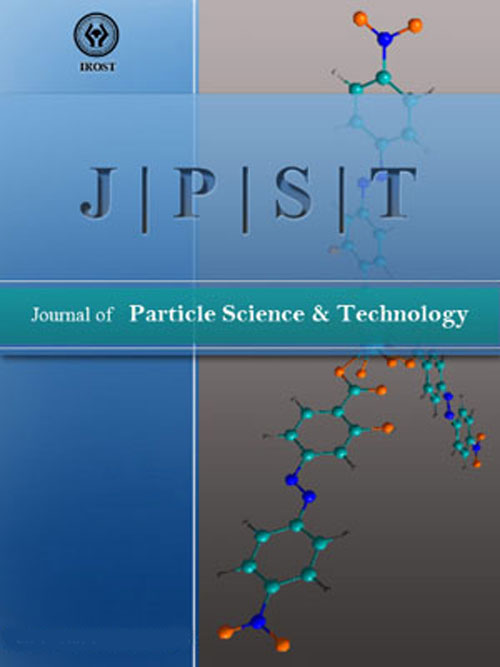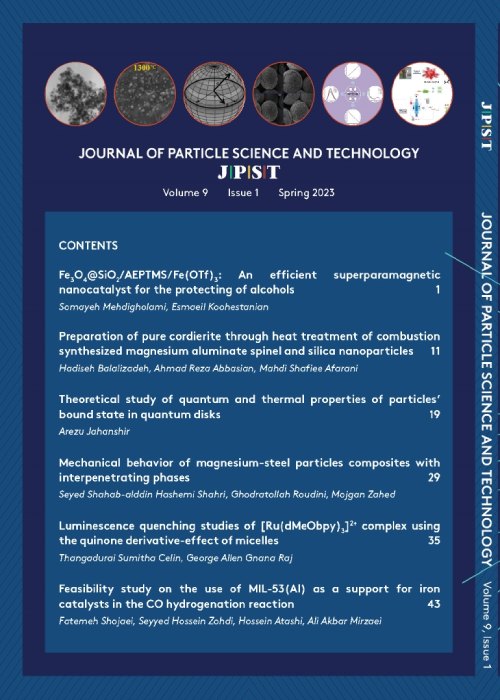فهرست مطالب

Journal of Particle Science and Technology
Volume:2 Issue: 2, Spring 2016
- تاریخ انتشار: 1396/01/30
- تعداد عناوین: 6
-
-
Pages 55-68Viscosity, electrical conductivity and deposit weight were determined for Electrophoretic deposition (EPD) Mg2+, Y3+, La3+ and Ce4+doped alumina's ethanolic suspensions prepared at dopant concentration between 350 to 1350 ppm. The concentration of XCly (X, y were: Mg, 2; Y, 3; Ce, 3 and La, 3, respectively) the charging salt, is also found to be a critical factor to control the viscosity. It is shown that the deposit weight is influenced by precursor concentration, but not by conductivity, viscosity or the pH of the suspension. All two way concentration interactions without Mg2 and Ce4 concentration simultaneous change are significantly in analysis of variance (ANOVA) model. The viscosity of suspension reached 2.5 mPa.s with Mg2+, Y3+, La3+ and Ce4+ decreased to 100, 100, 100 and 0 ppm in low iodine concentration (400 ppm), due to the most heavily cations that can adsorb to alumina surface with iodine adsorption but lighter Mg2+ cations adsorb under the influence of OH groups excite on alumina surface. The interest in the present study is to achieve a model between viscosity and additive concentration.Keywords: Electrophoretic deposition, ANOVA, dopant, Viscosity, sintering aid
-
Pages 69-77In the current study, synthesis and characterization of a new nano-structured zirconium(IV)-minoxidil complex (1), where minoxidil, (C9H15N5O; 6-(1-Piperidinyl)-2,4-pyrimidinediamine 3-oxide), have been investigated in two different solvents. The compound 1 has been synthesized by sonochemical method in the presence of methanol and monoethylene glycol (MEG) as solvents and characterized by scanning electron microscopy (SEM), Fourier transform infrared (FT-IR) spectroscopy and elemental analysis. The thermal stability of the compound 1 has been studied by thermal gravimetric (TG) and differential thermal analyses (DTA). Pure monoclinic (m) zirconia (ZrO2) nanoparticles were readily synthesized from thermal decomposition of the compound 1 as a new precursor in both solvents. The products were characterized by FT-IR, XRD, and SEM to exhibit the phase and morphology. The results showed that, pure zirconia was produced with particles size of 53 nm and the crystal system was monoclinic when methanol was used as solvent in complexation process. While the particles size of zirconia with the same structure were significantly reduced to 25 nm, using MEG as solvent. This study demonstrates that the coordination compounds may be suitable precursors for the simple one-pot preparation of nano-scale metal oxides with different morphologies.Keywords: Zirconia nanoparticles, Monoclinic, Zr(IV) complex, Sonochemical method, Thermal decomposition
-
Pages 79-85In this research, a mineral barite powder was reduced by carbon monoxide gas and the effects of reduction time and temperature was investigated as well as barite particle size. Results showed that the best result would be feasible when the barite particle sizes are between (-70 흍) in mesh scale. The barite reduction could reach the maximum level (98%) after reduction by carbon monoxide at 850°C for one hour. Meanwhile, the same amount of reduction could have been achieved in shorter time intervals at higher temperatures. The kinetics model for reduction process was also determined and activation energy was calculated.Keywords: Barite, Carbon monoxide, Activation energy
-
Pages 87-93Undoped and Tin (Sn) doped Molybdenum trioxide (α-MoO3) nanostructured thin films (which has lamellar (2D) structure) have been prepared using a simple and cost effective technique of spray pyrolysis on glass substrates at 450 ℃. Surface morphology, optical and structural properties of samples have been investigated using FESEM, UV-Vis spectroscopy and XRD analysis techniques, respectively. FESEM images showed the formation of some discrete micro-spheres on the surface, which with the increasing in the amount of dopant homogenous and dense nano-platelets was grown on top of these micro-spheres. The XRD pattern analysis shows that all samples have been grown in orthorhombic (α-MoO3) crystal structure and except for the sample doped with 50 at% Sn which had a weak peak of SnO2, no peak have been observed corresponding to the incorporation of Sn. By increasing the amount of impurity, optical transmittance of samples were increased from ~27 to 50%. Also, the band gap of samples were calculated using transmission data. An increasing of band gap from 3.34 to 3.89 eV was observed with increasing in the amount of doping.Keywords: Crystal structure, Molybdenum trioxide, Micro-spheres, Nano-platelets, Spray pyrolysis
-
Pages 95-102In order to obtain the best performance of the solar air heaters, it is necessary to find optimum performance conditions. The aim of this research paper is to achieve optimum conditions, by comparing single and double pass solar air heaters. Also, a brief review study of various related research works of all scenarios for a single and double pass and packed bed (including particle technologies) solar air heaters was carried out to observe the challenges of the mentioned systems. Energy modeling and simulation with EES and MATLAB open source code software indicated significant results in efficiency. According to the obtained results, it can be explained that double pass duct not necessarily always increases the overall system energy efficiency. Results of this work indicate, higher ambient air temperature (inlet air temperature) and lower solar irradiation can increase overall energy efficiency of solar double pass systems. More precisely at solar irradiation of 916 W/m2 and inlet air temperature of 302 οK, the system achieves the targeted optimum value in energy efficiency, approximately 90%, which is considerably more than the 65% as an average value.Keywords: Energy modeling, Energy performance, Particles parameters, Heat transfer


